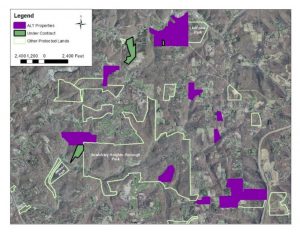September 5, 2017
For Immediate Release
Pittsburgh, PA – Five environmental nonprofits have established an innovative Shared Chief Financial Officer (CFO) position, which launched last week.
Allegheny Land Trust (ALT), Hollow Oak Land Trust (HOLT), Pennsylvania Resources Council (PRC), Three Rivers Waterkeeper (TRW), and Venture Outdoors (VO) formed the resource-sharing position to increase the abilities of each nonprofit to produce better reporting, transparency, financial management capabilities and strategic financial planning.
Karen Wood, CPA was hired by the five nonprofits to take on the responsibility of collaborating with each organization’s leadership and boards in managing finances and growth of each organization. The shared CFO position was modeled after two other successful shared CFO collaboratives in Pittsburgh–The Environmental Finance Collaborative and The Arts Finance Cohort. Learning from those programs, the nonprofits adapted those programs to allow Wood to service a cohort of varying size, complexity and geographic reach.
“In a City where the not for profit community provides so many critical resources, it is imperative that this work takes advantage of opportunities to realize efficiencies. The shared CFO model is designed to provide significant financial expertise to a broad group of organizations and in a structure which maximizes the new resource while minimizing the cost to each organization,” Justin Stockdale, Western Regional Director of the Pennsylvania Resources Council, said. “These five organizations will each become stronger as we collaborate in employment of this executive level financial resource.”
Each nonprofit works to improve the region’s environmental health, making the partnership a natural one as they have aligned missions and funding streams.
“We wanted to ensure the shared CFO could have the time and focus to be able to intimately understand each nonprofit’s mission and to align financial management capabilities in support of those goals.,” Venture Outdoors Executive Director Joey-Linn Ulrich said. “Many of us have used for-hire intermittent services or consultants that don’t quite meet our goals or strategic financial planning that we can get through this program.”
Wood is a Pennsylvania licensed Certified Public Accountant (CPA), and a member of the American Institute of CPA’s and of the Pennsylvania Institute of CPA’s. She has worked for the past nine years with Ruzomberka Holland Renk Smith (RHRS), a full-service accounting firm based in Franklin Park. In her position with RHRS, Karen specialized in all aspects of nonprofit accounting and consulting, accounting software consulting and support, bookkeeping support and client care, and payroll and sales taxes, in addition to providing tax, accounting and attest services.
“I am honored to be part of this highly respected team of organizations, who put forth such enormous efforts every day to make our region and state a better place to live for all of us. In over 30 years of working with nonprofits, I am all too familiar with the common paradox that small to mid-sized organizations face, of complicated finances paired with tiny administrative budgets. The result is that most of these organizations operate without the kind of support they need to be able to stay on top of a complicated web of operating finances, complex accounting rules, and agency regulations,” Wood said. “I look forward to helping each organization improve their efficiency, gain valuable insights on the costs and benefits of their programs, and access more useful information for budgeting, management and oversight.”
The goals for the position are to increase the efficiency, planning, performance and reporting capabilities of each organization to ensure ongoing financial sustainability and ability to achieve mission related goals.
—
About Allegheny Land Trust (ALT)
Founded as a nonprofit in 1993 in response to the rapidly declining amount of green space in Allegheny County, ALT has protected more than 2,100 acres to preserve our region’s unique natural beauty, provide accessible outdoor recreational opportunities, improve water quality, sustain biodiversity, and enhance the overall quality of life for all. ALT’s mission has expanded in recent years to include innovative methods of land conservation in support of community needs for urban green space as well the addition of a professional environmental education team teaching people of all ages to understand and appreciate the natural world. More information can be found at alleghenylandtrust.org.
About Hollow Oak Land Trust (HOLT)
Founded in 1991, the HOLT is a nonprofit conservation organization that protects and connects greenspace with an emphasis in the Pittsburgh Airport Corridor. Currently protecting five conservation areas and two easements, totaling nearly 500 acres, HOLT protects land to maintain and enhance their ecological values. Protected wildlife habitats include mature forest, steep slopes, floodplains, wetlands, and meadows. More information can be found at hollowoak.org.
About Pennsylvania Resources Council (PRC)
PRC is Pennsylvania’s oldest grassroots environmental organization. Since 1939, PRC has worked to protect the Commonwealth’s resources for future generations through environmental education, recycling and waste diversion programs, anti-litter campaigns, and much more. PRC’s mission is to lead and promote individual and collective actions to preserve Pennsylvania’s environmental resources for each generation. More information can be found at prc.org.
About Three Rivers Waterkeeper (3RW)
3RW mission is to protect the water quality of the Monongahela, Allegheny, and Ohio Rivers, and their respective watersheds. 3RW do this by patrolling the rivers with the Waterkeeper boats, monitoring water quality, evaluating incidents of pollution, reviewing permits, supporting community education, and holding polluters accountable to our nation’s clean water laws. More information can be found at threeriverswaterkeeper.org.
About Venture Outdoors (VO)
Venture Outdoors is a nonprofit organization dedicated to connecting everyone to the benefits of outdoor recreation throughout Southwestern Pennsylvania. We believe everyone deserves the chance to experience how incredibly fun the outdoors can be, so we provide the gear, guidance, and inspiration to make outdoor recreation¬ part of people’s lives. Venture Outdoors offers over 800 programs a year including kayaking, hiking, biking, snowshoeing, fishing, cross country skiing, and geocaching trips for all ages and skill levels. More information can be found at ventureoutdoors.org.

